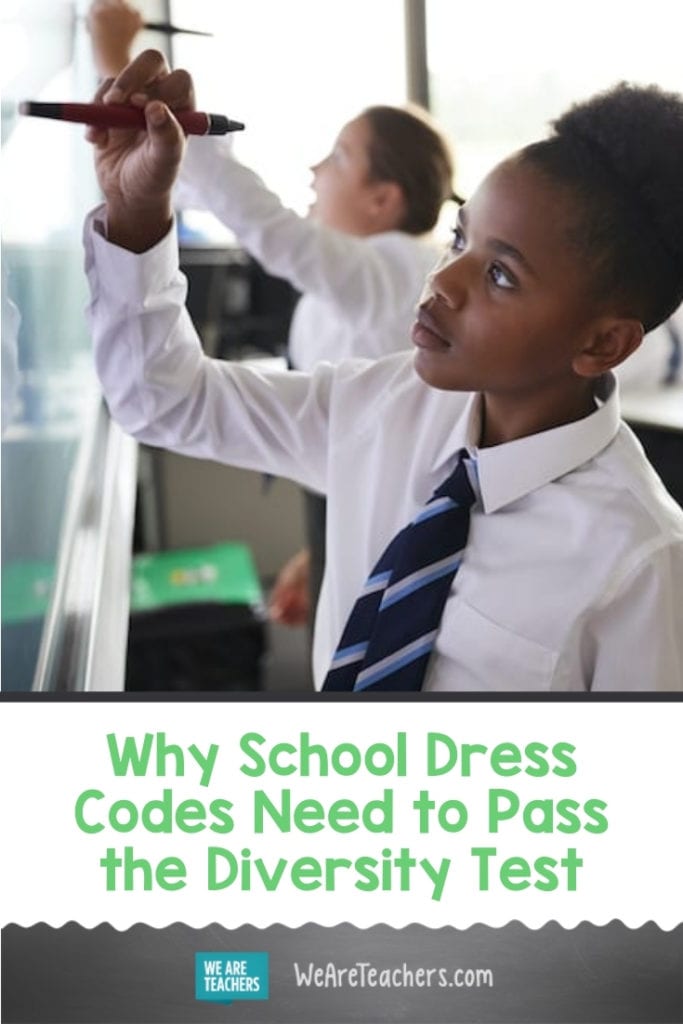We’ve all wondered what to wear to a special event, restaurant, or professional conference. If you’ve worked in a school, you know expectations exist for both students and teachers too. Have you ever questioned whether the requirements were inclusive for all? A critical step towards creating an anti-racist learning environment is to ensure that school dress codes pass the diversity test.
For far too long, students (and teachers) have faced discrimination due to problematic policies. Schools have denied access to enrollment or even graduate because a student’s hair didn’t fit their standards. Or they weren’t wearing the “right” type of clothes. These stories make headlines across the country year after year, and it’s time to put that to an end.
Dress Codes and Black Hair
High school wrestler, Andrew Johnson, had to cut his cheekbone-length dreadlocks before a match or leave the competition. Teachers turned six-year-old Clinton Stanley, Jr. away on the first day of school because they deemed his dreadlocks “too long.” DeAndre Arnold faced in-school suspension and the threat of not graduating with his dreads. And educators pulled Mya and Deanna Cook out of class because their braids were too “distracting.”
When the district’s superintendent, Greg Poole, was questioned over the treatment of DeAndre Arnold, he simply said, “Our policy limits the length. It’s been that way for 30 years.” Fortunately, times are changing. Now, states and cities are banning hair discrimination. And our country’s largest teachers union is calling on educators to demand inclusive school hair policies.
At the start of the 2019 school year, the National Education Association took to Twitter. “Some states, but not enough, have banned hair discrimination — an important step in protecting students against implicit and explicit bias.” They also provided a link to a fantastic article on their site, “When Natural Hair Wins, Discrimination in School Loses.”
While some feel that a dress code is important to school culture, many policies are rooted in a white-centered view of beauty. Too often, people view dreadlocks, braids, headwraps, and natural hairstyles as unprofessional. It is not reasonable to expect Black students to dramatically change their natural hair. Black hair does not need to be fixed, and we must unite against policies that suggest otherwise.
Culture and Dress Codes
A common trend for dress codes is the “white male default.” An enlightening piece on neaToday explains that “Dressing as most white young men do seems to be what is encouraged.” As a result, females and minority students are most often in violation. In the article, Maddie Reeser, a Baltimore City public school student, says Black girls are most frequently dress coded. Another student agreed and asked a male administrator about her concerns. He responded, “white girls don’t have as much to show.” This is really happening, and it’s impacting students.
According to a 2018 National Women’s Law Center (NWLC) study, dress coding can cause Black students to fall behind academically. “It’s outrageous that girls are losing critical class time simply for what they are wearing,” said Kayla Patrick, NWLC Education Fellow and co-author of the report. “This sends a disturbing message to all students: What a girl looks like is more important than what she learns and thinks. No girl should ever have to forfeit her education because her shirt is the wrong color or she has a hole in her jeans.”
Meanwhile, as Marci Kutzer, a fourth-grade teacher at Bertha Ronzone Elementary in Las Vegas, explains, “Targeting styles of clothing that are mostly associated with a particular minority group is discriminatory. When styles such as ‘sagging pants’ are the issue, we are putting a burden predominantly on Black males.” Unfortunately, these types of policies should impact all students, but seem more strongly enforced with Black kids.
Dress Codes Should Be Gender Neutral
We hear about girls and dress codes all the time. There’s the Texas honors student who got sent home for wearing yoga pants (with an oversized shirt to cover her backside). A Kentucky student showed off her collarbone (and was still deemed “inappropriate” after covering up with a scarf). And a 12-year-old student was suspended and missed three days of class over tight pants.
“If we just police what girls are wearing, it implies that the onus is on the girl to prevent any kind of inappropriate behavior from someone else because of what she’s wearing,” says Coshandra Dillard, a writer at Teaching Tolerance. “I’m not sure if schools realize how harmful that is to shame or blame girls for how someone may react rather than addressing that issue in particular. There shouldn’t be inappropriate behavior, period.”
As discussed previously, Black girls find themselves dress coded more frequently. Boys do as well. The belief that only girls should have long hair is one reason Andrew Johnson, Clinton Stanley, Jr., and De’Andre Arnold were expected to cut their hair.
The Human Rights Campaign states that dress codes should be free from gender stereotypes. Especially because they can add extra burdens for Black students (and teachers). Grooming guidelines, including those pertaining to hairstyles, can lead to discrimination based on race. By using gender-neutral language and removing gender-specific expectations, we create a more inclusive learning environment.
Creating Better School Dress Codes
We should all want every one of our students to feel welcomed. Learning new concepts and navigating interpersonal relationships is challenging enough without kids having to worry if too much of their collarbone is showing or if their hairstyle will prevent them from graduating. They deserve so much more than that.
When creating a better school dress code for diversity, it’s essential to consider the following:
-
- Religion — As the Anti-Defamation League explains, while the First Amendment allows for mandatory uniform policies or dress codes in public schools, it generally permits exemptions for students to wear religious clothing, head coverings, symbols, or other attire. “Under many circumstances policies or codes that prohibit students from wearing religious clothes or other attire are unconstitutional or unlawful.”
- Economic status — Dress codes that require students to wear specific clothing or colors can make it difficult for lower-income families to comply.
- Disabilities — Make reasonable accommodations for students with disabilities who may need to modify attire and footwear.
- Gender neutrality — The Human Rights Campaign (HRC) asserts that we should “Avoid gender-specific policies altogether and instead allow all students the same clothing choices regardless of gender.”
- Inclusivity — A reasonable dress code is inclusive and does not “discriminate against any student on the basis of gender identity, sexual orientation, sex, race, ethnicity, religion, or any other aspect of an individual’s identity.”
- Simplicity — Complicated dress codes don’t work for anyone. Keep it simple, like the Portland Public School’s policy, which only mandates what parts of the body need to be covered.
- Communication — Make the expectations crystal clear to avoid confusion, providing examples, definitions, and photographs whenever possible.
- Infractions — “Dress code infractions should be considered minor,” according to the HRC. “Discipline should not involve removing a child from their learning environment. School staff should also avoid shaming.”
While dress codes have been considered problematic for many students, some feel that they’ve become a modern “whites only” sign. These policies can have a direct, negative impact on the educational success of minority students. We all want the kids in our classrooms to succeed, which is why we need to take action.
Do We Need Dress Codes?
School dress codes have become such a point of contention that some wonder if we even need them. Mikaela Savarese, a fifth-grader at Kensington Elementary School, wrote an entire column: “Schools Don’t Need Dress Codes.” She argued that these policies are impractical, expensive, and rob students of self-expression, among other things.
Additionally, when staff tell students that cultural clothing or hairstyles are “inappropriate,” such as in the case of high school senior, Tvli Birdshead who was initially blocked from wearing Native American regalia at his graduation, the policies become discriminatory. This can damage their sense of identity and self-worth.
Despite the ongoing Black Lives Matter movement, some schools are standing firm on their non-inclusive dress codes. The school that told De’Andre Arnold that he couldn’t graduate unless he cut his dreadlocks has actually doubled down on their rules even as a wave of other states have overturned these policies.
As The Education Trust states,” ‘It’s against the dress code’ is one of those answers we are often told to accept at face value. Students are often told their attire is “inappropriate,” and that this is a matter of self-discipline and character. They are even sent home on the basis that what they are wearing is disrespectful. But we rarely question what purpose these rules serve, who these rules exclude, and how these rules impact students’ mental and emotional well-being. It’s high time we start.”
So, where does that leave us? Is it time to get rid of dress codes entirely, or should educators look at the Portland Public Schools’ policies as a step in the right direction? We won’t know unless we try, but clearly, it’s time to do something different. We can’t continue to hurt our children with unfair or discriminatory policies. Especially when these policies clearly impact education.
Working Together
It doesn’t matter if you believe schools need dress codes or want to see them abolished. We need to work together to create a safe and inclusive environment for students. The HRC’s Welcoming Schools is a program “dedicated to creating respectful and supportive elementary schools in embracing family diversity, creating LGBTQ-inclusive schools, preventing bias-based bullying, creating gender-expansive schools, and supporting transgender and non-binary students.”
We continue to tackle the many layers of systemic racism and discrimination in all levels of our society. Now is the time to undertake professional development training. Now we need to become better equipped at identifying and addressing language, behaviors, and policies that can hurt our students.
The American Civil Liberties Union (ACLU) has a great list of things schools can and can’t do when it comes to school dress codes. Make it your mission to review the rules your school has put in place for students. Think critically about whether the expectations are inclusive and reasonable. Challenge anything that seems unfair. Support students who feel targeted. And examine any of your own biases before dress coding a student. We need your voice.
How do you feel about school dress codes and diversity? Share in our Principal Life Facebook group.
Also, our favorite books about racial justice for the classroom.


